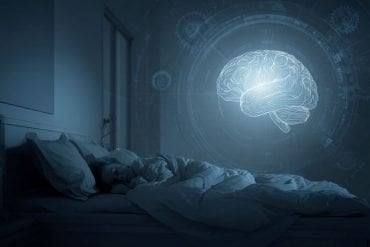Summary: Two distinct networks in the frontal and temporal lobes become activated and work in unison to integrate the meaning of words in order to obtain a higher-order and more complex meaning when reading.
Source: UT Houston
When a person reads a sentence, two distinct networks in the brain are activated, working together to integrate the meanings of the individual words to obtain more complex, higher-order meaning, according to a study at UTHealth Houston.
The study, led by Oscar Woolnough, PhD, postdoctoral research fellow in the Vivian L. Smith Department of Neurosurgery with McGovern Medical School at UTHealth Houston, and Nitin Tandon, MD, professor and chair ad interim of the department in the medical school, was published today in The Proceedings of the National Academy of Sciences (PNAS).
“This study helps us better understand how distributed hubs in the brain’s language network work together and interact to allow us to understand complex sentences,” said Woolnough, first author on the study and member of the Texas Institute for Restorative Neurotechnologies (TIRN) at UTHealth Houston.
“Our brains are remarkably interconnected, and for us to understand language requires a precise sequence of rapid, dynamic processes to occur in multiple sites all across our brain.”
In order to identify the specific roles and interactions of the brain areas involved in reading, the research team performed recordings from the brains of patients with electrodes surgically placed to localize epilepsy.
The neural activity of these patients was measured while reading three forms of sentences: regular sentences; “Jabberwocky” sentences (based on Lewis Carroll’s “Jabberwocky” poem), which use correct grammar and syntax but contain nonsense words, making them meaningless; and lists of words or nonsense words.
From these recordings, they identified two brain networks that play a key role in the reading process. One network involves a region of the brain’s frontal lobe that sends signals to the temporal lobe, which shows progressive activation when a person is building up complex meaning along the length of a sentence.

The second network involves another region of the brain’s temporal lobe that sends signals to an area of the frontal lobe, allowing understanding of the context of a sentence to enable easier comprehension and processing of each new word that is read.
“Implanted electrodes in the brain provide us an unparalleled insight into the inner workings of the human mind, especially for processes that are rapid, such as reading.
“Our work is making it clear that most processes – say comprehension or language generation – don’t occur in a single region, but are best understood as very transient states that many separate areas of the brain achieve by very brief, yet critical, interactions,” said Tandon, the study’s senior author, who is also the Nancy, Clive and Pierce Runnels Distinguished Chair in Neuroscience of the Vivian L. Smith Center for Neurologic Research and the BCMS Distinguished Professor in Neurological Disorders and Neurosurgery with McGovern Medical School.
Understanding the science behind the highly rapid, complex process of reading will allow the researchers to learn more about how the brain functions during dyslexia. Ultimately, they hope their findings will help guide treatment options for the reading disorder, which affects approximately 15% of people living in the U.S.
Funding: The research was funded through a five-year, $4.4 million grant from the National Institutes of Health Brain Research Through Advancing Neurotechnologies (BRAIN) Initiative, which aims to accelerate the development and application of innovative technologies to produce a new dynamic picture of the human brain.
Co-authors on the paper with McGovern Medical School’s neurosurgery department included Cristian Donos, PhD, who is now with the University of Bucharest in Romania; Elliot Murphy, PhD; Patrick Rollo; and Zachary Roccaforte. Murphy, Rollo, Roccaforte, and Tandon are also members of TIRN, and Tandon is a faculty member with The University of Texas MD Anderson UTHealth Houston Graduate School of Biomedical Sciences. Also contributing was Stanislas Dehaene, PhD, with Universite Paris-Saclay in France and the College de France.
About this neuroscience research news
Author: Caitie Barkley
Source: UT Houston
Contact: Caitie Barkley – UT Houston
Image: The image is in the public domain
Original Research: Closed access.
“Spatiotemporally Distributed Frontotemporal Networks for Sentence Reading” by Oscar Woolnough et al. PNAS
Abstract
Spatiotemporally Distributed Frontotemporal Networks for Sentence Reading
Reading a sentence entails integrating the meanings of individual words to infer more complex, higher-order meaning. This highly rapid and complex human behavior is known to engage the inferior frontal gyrus (IFG) and middle temporal gyrus (MTG) in the language-dominant hemisphere, yet whether there are distinct contributions of these regions to sentence reading is still unclear.
To probe these neural spatiotemporal dynamics, we used direct intracranial recordings to measure neural activity while reading sentences, meaning-deficient Jabberwocky sentences, and lists of words or pseudowords.
We isolated two functionally and spatiotemporally distinct frontotemporal networks, each sensitive to distinct aspects of word and sentence composition.
The first distributed network engages the IFG and MTG, with IFG activity preceding MTG. Activity in this network ramps up over the duration of a sentence and is reduced or absent during Jabberwocky and word lists, implying its role in the derivation of sentence-level meaning.
The second network engages the superior temporal gyrus and the IFG, with temporal responses leading those in frontal lobe, and shows greater activation for each word in a list than those in sentences, suggesting that sentential context enables greater efficiency in the lexical and/or phonological processing of individual words.
These adjacent, yet spatiotemporally dissociable neural mechanisms for word- and sentence-level processes shed light on the richly layered semantic networks that enable us to fluently read.
These results imply distributed, dynamic computation across the frontotemporal language network rather than a clear dichotomy between the contributions of frontal and temporal structures.






